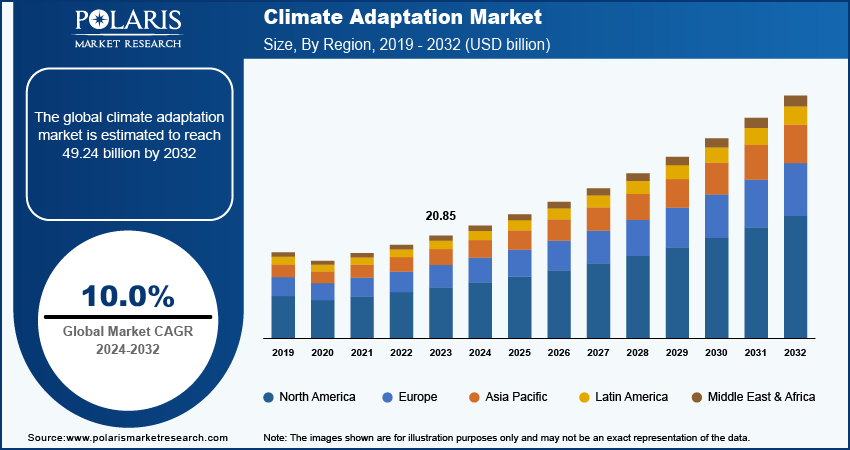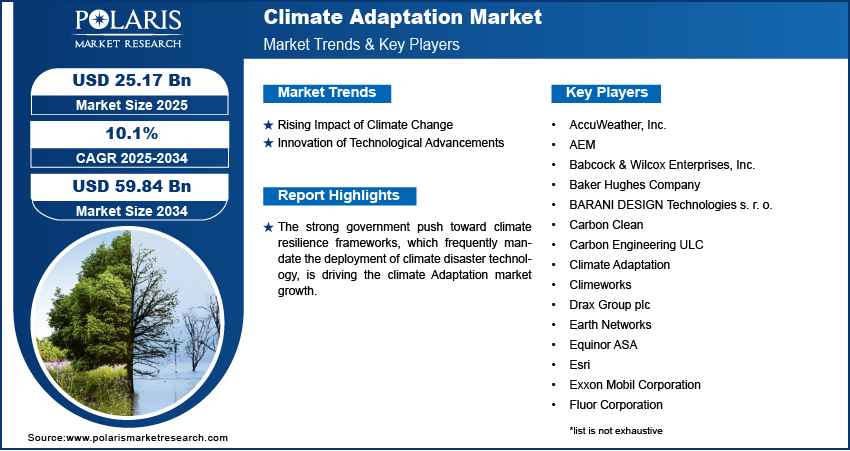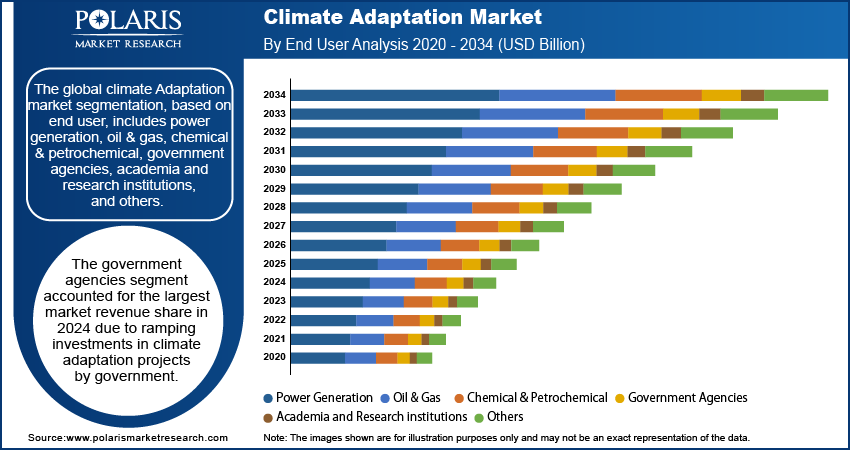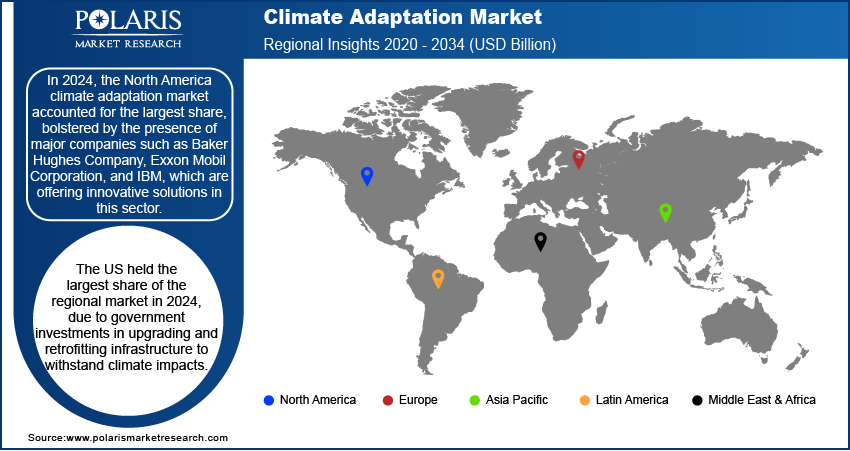
Climate Adaptation Market Size, Share, Trends, Industry Analysis Report: By Type (Nature-Based, Technology-based, Enhanced Natural Process, Early Climate Warning & Environment Monitoring), End User, and Region (North America, Europe, Asia Pacific, Latin America, and Middle East & Africa) – Market Forecast, 2024 - 2032
- Published Date:Oct-2024
- Pages: 115
- Format: PDF
- Report ID: PM5077
- Base Year: 2023
- Historical Data: 2019-2022
Climate Adaptation Market Overview
Global Climate Adaptation market size was valued at USD 20.85 billion in 2023. The market is projected to grow from USD 22.90 billion in 2024 to USD 49.24 billion by 2032, exhibiting a CAGR of 10.0% during the forecast period (2024 - 2032).
Climate Adaptation refers to the process of adjusting practices, policies, and infrastructure to mitigate the adverse effects of climate change and enhance resilience to its impacts. Unlike climate moderation, which focuses on reducing or preventing the causes of climate change, adaption seeks to manage and cope with its consequences.
The public awareness of climate change impacts is growing, leading to increased demand for solutions that mitigate these impacts and adapt to changing conditions. Furthermore, organizations are recognizing the financial risks associated with climate change and are investing in adaption strategies to protect their operations, supply chains, and investments. This has led to a growing Climate Adaptation market products and services.
For instance, in February 2022, the Global Environment Facility (GEF) member approved $203 million in targeted Climate Adaptation investments. These funds are aimed at bolstering food systems, water resources, and early warning systems in least-developed countries, small island developing states, and other vulnerable nations facing escalating climate risks.

To Understand More About this Research: Request a Free Sample Report
Government policies, regulations, and international agreements aimed at reducing greenhouse gas emissions and promoting resilience to climate change are driving demand for solutions in the Climate Adaptation market.
Climate Adaptation Market Trends
Rising Impact of Climate Change
The increasing climate change impacts are driving the Climate Adaptation market CAGR. The increased occurrence of extreme weather events such as hurricanes, floods, and heatwaves necessitate robust adaption strategies. Governments, businesses, and communities are investing in solutions to mitigate the damage and enhance resilience against these events. This growing need for adaptive measures contributes to the market's expansion.
Policies and regulations increasingly mandate adaption measures to address climate risks. This regulatory environment creates a driving force for investment in the Climate Adaptation market. Organizations and governments seek to comply with new standards by adopting a comprehensive program to increase awareness and enhance the understanding of climate change impacts, thereby driving demand for solutions in the Climate Adaptation market.
For instance, in December 2023, Serbia launched its inaugural Programme for Adaption to Changed Climatic Conditions, spanning from 2023 to 2030, along with an accompanying Action Plan. The program underscores that Serbia is experiencing warming at a rate faster than the global average of 1.8 degrees Celsius compared to the global increase of 1.1 degrees Celsius, with summer temperatures rising by 2.6 degrees Celsius. These initiative aims to enhance awareness, improve understanding, and address the impacts of climate change more effectively on a global scale.
Innovation of Technological Advancements
The Climate Adaptation market is experiencing significant growth, driven by the innovation of technological advancements in Climate Adaptation. Innovations in technology, such as better weather forecasting system, digital technologies track climate solutions, advanced materials for infrastructure resilience, and renewable energy solutions, are driving growth in the Climate Adaptation market. These technologies help mitigate and adapt to the effects of climate change more effectively.
Multilateral organizations, development banks, and international donors are providing support for Climate Adaptation projects in vulnerable regions, boosting market growth.
For instance, in November 2023, the World Bank Group highlighted how digital technologies are revolutionizing global efforts to combat climate change. These technologies are pivotal in reducing emissions across industries, fostering greener transportation networks, and enhancing early warning systems to mitigate climate impacts. Governments are increasingly seeking urgent and scalable solutions to address the climate crisis, with digital tools playing a crucial role.
This report serves as a precursor to initiatives at COP28, where the launch of the Green Digital Action Track aims to mobilize industry-wide commitments to tackle climate challenges. The focus will be on promoting inclusive digital solutions as central to these efforts. Such developments underscore the growing demand for Climate Adaptation solutions, driving growth in the Climate Adaptation market revenue.

Climate Adaptation Market Segment Insights
Climate Adaptation Market Breakdown by Type Insights
The global Climate Adaptation market segmentation, based on type, includes nature-based, technology-based, enhanced natural process, and early climate warning & environment monitoring. The early climate warning and environmental monitoring segment is expected to experience the highest CAGR in the climate adaptation market during the forecast period. As climate change intensifies, leading to more frequent and severe extreme weather events, the demand for early warning systems (EWS) is steadily increasing. This growing awareness of the need for timely and accurate information to mitigate the impacts of such events is driving investment and innovation in this crucial area of climate adaptation.
EWS are cost-effective measures for disaster risk reduction and Climate Adaptation, proven to protect lives, livelihoods, and ecosystems. These systems help communities and governments prepare and respond effectively, reducing damage and saving lives by increasingly investing in these systems to enhance resilience and preparedness.
For instance, according to the UN Environment Programme, climate change is expected to increase the frequency and intensity of climate-related hazards. Multi-Hazard Early Warning Systems (MHEWS) significantly reduce disaster risk and minimize damage by enabling informed decision-making.
In November 2022, at COP27, the UN Secretary-General launched the Early Warnings for All (EW4All) initiative. This initiative aims to implement global early warning systems by the end of 2027. Such launch is driving the high growth rate projected for the early climate warning and environmental monitoring segment in the Climate Adaptation market.
Climate Adaptation Market Breakdown by End User Insights
The global Climate Adaptation market segmentation, based on end user, includes power, generation, oil & gas, chemical & petrochemical, government agencies, academia and research institutions, and others. Government agencies are expected to witness the fastest-growing CAGR during the forecast period. Governments are ramping up investments in Climate Adaptation projects. This includes funding for infrastructure improvements and other measures designed to mitigate the impacts of climate change. This surge in investment drives Climate Adaptation industry growth.
By releasing an updated Climate Adaptation Plan, the federal agencies are also contributing to the overall goal of making federal operations more resilient to climate change. This involves improving systems, processes, and infrastructure to better withstand and recover from climate impacts.
For instance, in June 2024, NASA joined 20 federal agencies to release its updated Climate Adaptation Plan. This initiative supports the Biden-Harris Administration's goal of enhancing federal operations' resilience to climate change impacts. The updated plan advances the National Climate Resilience Framework, which aligns climate resilience investments across both public and private sectors through shared principles and opportunities. Additionally, the Biden-Harris Administration is boosting climate resilience by allocating over $50 billion toward related efforts. These are driving rapid growth within the Climate Adaptation market.

Climate Adaptation Market Breakdown by Regional Insights
By region, the study provides market insights into North America, Europe, Asia Pacific, Latin America, and the Middle East & Africa. In 2023, the North America climate adaptation market accounted for the largest share, bolstered by the presence of major companies such as Baker Hughes Company, Exxon Mobil Corporation, and IBM, which are offering innovative solutions in this sector. Key market players are actively merging, acquiring, and collaborating to enhance their market presence and improve their offerings. This strategic activity is expected to further drive the market growth during the forecast period, positioning North America as a leader in climate adaptation initiatives.
The US Climate Adaptation market held the largest share due to government investment in upgrading and retrofitting infrastructure to withstand climate impacts.
For instance, according to the United Nations Environment Programme, COP28 began with significant developments in Climate Adaptation. The global community agreed to activate the Loss and Damage Fund, which will offer financial support to countries most affected by climate change. First introduced in 2022, this fund received nearly $300 million in pledges during COP28.
The US committed $3 billion to the Green Climate Fund, raising its total replenishment to nearly $13 billion, with half of this amount allocated for adaption efforts. The US also announced $1 billion for climate and health initiatives, approximately $200 million for the Global Environment Facility, and around $170 million for the Adaption Fund. These developments significantly increase the Climate Adaptation market share.
Climate Adaptation market in Canada held a significant share with extensive and aging infrastructure, including transportation networks, buildings, and coastal defenses, which is increasingly vulnerable to climate change. There is significant demand for upgrading and retrofitting infrastructure to enhance resilience, which drives the market for Climate Adaptation solutions.
For instance, in June 2023, the International Institute for Sustainable Development (IISD) reported the release of Canada’s first National Adaption Strategy (NAS). The NAS adopts a comprehensive approach to Climate Adaptation, focusing on enhancing resilience across society and bolstering Canadian economies against the growing risks of climate-related disasters.
Asia Pacific Climate Adaptation market is expected to grow at the highest CAGR from 2024 to 2032. This is due to severe threats from climate change-induced disasters. Crucial collaborative action is needed to manage disaster risks and enhance climate resilience.
For instance, according to the Economic and Social Commission for Asia and the Pacific (ESCAP), ESCAP and UNDP are running a two-year collaborative SDG-funded project (2022-2023) to integrate Disaster Risk Reduction and Climate Change Adaption into national and sub-national development plans. This initiative aims to improve the achievement of SDGs and Agenda 2030. As part of the project, ESCAP has developed an updated risk profile using high-resolution climate projections and geospatial techniques to help stakeholders make informed decisions.
Climate Adaptation market in India held a significant market share in 2023 due to increased awareness of climate change. On the other hand, Japan's Climate Adaptation market is expected to continue its steady growth during the forecast period due to advancements in Climate Adaptation technologies, including early warning systems, resilient infrastructure, and data analytics.

Climate Adaptation Key Market Players & Competitive Insights
Leading market players drive innovation and implement solutions in infrastructure, technology, and policy. Understanding these players and their initiatives provides valuable insights into the competitive landscape and emerging opportunities in the Climate Adaptation market. Successful market developments enhance industry presence and influence the competitive edge.
Access to funding from government programs, international organizations, and private investors is critical for advancing adaption projects. Key players that secure substantial funding is better equipped to undertake large-scale initiatives and drive Climate Adaptation industry growth.
Major players in the Climate Adaptation market include AccuWeather, Inc.; AEM; Babcock & Wilcox Enterprises, Inc.; Baker Hughes Company; BARANI DESIGN Technologies. r. o.; Carbon Clean; Carbon Engineering ULC; Climate Adaptation; Climeworks; Drax Group plc.; Earth Networks; Equinor ASA; Esri; Exxon Mobil Corporation; Fluor Corporation; Global Thermostat; Heirloom Carbon Technologies; IBM; Metasensing; OnSolve; Previsico Limited; SLB; Soletair Power; The Nielsen Company; Vaisala; etc.
International Business Machines Corporation (IBM) is an American multinational technology company operating in over 75 countries. The company provides healthcare and healthcare payer solutions through the IBM Watson Health business. IBM Watson started in 2010, is a supercomputer that uses Digital Workplace (AI) and advanced analytical tools to operate optimally as a "question-answering" machine. For businesses and organizations, IBM Watson uses Digital Workplace to optimize employees' time, automate complex processes, and predict future outcomes. In March 2024, IBM pledged up to $45 million for Climate Adaptation, beginning with a new request for proposals (RFP) focused on developing resilient cities.
BARANI DESIGN Technologies s.r.o., founded in 2003 in Seattle, USA, specializes in manufacturing advanced weather stations and meteorological sensors for professional use, emphasizing durability and high-quality measurements. Notable products include their patented helical radiation shield and elliptic anemometer. The company’s flagship product, the MeteoHelix IoT Pro, is a highly precise micro-weather station designed for ease of use. In April 2019, BARANI DESIGN donated €20,000 worth of instrumentation to support climate change initiatives.
Key Companies in Climate Adaptation Market
- AccuWeather, Inc.
- AEM
- Babcock & Wilcox Enterprises, Inc
- Baker Hughes Company
- BARANI DESIGN Technologies s. r. o.
- Carbon Clean
- Carbon Engineering ULC
- Climate Adaptation
- Climeworks
- Drax Group plc
- Earth Networks
- Equinor ASA
- Esri
- Exxon Mobil Corporation
- Fluor Corporation
- Global Thermostat
- Heirloom Carbon Technologies
- IBM
- Metasensing
- OnSolve
- Previsico Limited
- SLB
- Soletair Power
- The Nielsen Company
- Vaisala
Climate Adaptation Industry Developments
October 2023: AEM introduced the AEM Elements Resiliency Platform, a comprehensive multi-hazard solution designed to equip communities and organizations with the critical insights and tools needed for effective natural disaster risk management and climate mitigation.
March 2023: Baker Hughes and HIF Global announced a collaboration to develop technology for capturing carbon dioxide directly from the atmosphere, aiming to support and accelerate the energy transition to address climate change.
May 2021: Babcock & Wilcox unveiled its ClimateBright suite, a groundbreaking set of decarbonization technologies intended to help utilities and industries significantly reduce greenhouse gas emissions and combat climate change.
Climate Adaptation Market Segmentation
By Type Outlook
- Nature-Based
- Technology-based
- Enhanced Natural Process
- Early Climate Warning & Environment Monitoring
By End user Outlook
- Power Generation
- Oil & Gas
- Chemical & Petrochemical
- Government Agencies
- Academia and Research institutions
- Others
By Regional Outlook
- North America
- US
- Canada
- Europe
- Germany
- France
- UK
- Italy
- Spain
- Netherlands
- Russia
- Rest of Europe
- Asia Pacific
- China
- Japan
- India
- Malaysia
- South Korea
- Indonesia
- Australia
- Vietnam
- Rest of Asia Pacific
- Middle East & Africa
- Saudi Arabia
- UAE
- Israel
- South Africa
- Rest of Middle East & Africa
- Latin America
- Mexico
- Brazil
- Argentina
- Rest of Latin America
Climate Adaptation Report Scope
|
Report Attributes |
Details |
|
Market Size Value in 2023 |
USD 20.85 billion |
|
Market Size Value in 2024 |
USD 22.90 billion |
|
Revenue Forecast in 2032 |
USD 49.24 billion |
|
CAGR |
10.0% from 2024 – 2032 |
|
Base Year |
2023 |
|
Historical Data |
2019 – 2022 |
|
Forecast Period |
2024 – 2032 |
|
Quantitative Units |
Revenue in USD billion and CAGR from 2024 to 2032 |
|
Report Coverage |
Revenue Forecast, Market Competitive Landscape, Growth Factors, and Industry Trends |
|
Segments Covered |
|
|
Regional Scope |
|
|
Competitive Landscape |
|
|
Report Format |
|
|
Customization |
Report customization as per your requirements with respect to countries, regions, and segmentation. |
FAQ's
The global Climate Adaptation market size was valued at USD 20.85 billion in 2023 and expected to grow at 49.24 billion in 2032.
The global market is expected to exhibit at a CAGR of 10.0% during the forecast period, 2023-2032.
North America held the largest share of the global market
The key players in the market are AccuWeather, Inc.; AEM; Babcock & Wilcox Enterprises, Inc.; Baker Hughes Company; BARANI DESIGN Technologies s. r. o.; Carbon Clean; Carbon Engineering ULC; Climeworks; Drax Group plc.; Earth Networks; Equinor ASA; Esri; Exxon Mobil Corporation; Fluor Corporation; Global Thermostat; Heirloom Carbon Technologies; IBM; Metasensing; OnSolve; Previsico Limited; SLB; Soletair Power; The Nielsen Company; Vaisala; etc.
The early climate warning & environment monitoring segment is projected to witness the highest CAGR in the Climate Adaptation market during the forecast period.
The government agencies are expected to witness the fastest growing CAGR during the forecast period.
